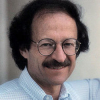Harold E. Varmus

Harold E. Varmus
Harold Eliot Varmusis an American Nobel Prize-winning scientist and was the 14th Director of the National Cancer Institute, a post to which he was appointed by President Barack Obama. He was a co-recipientof the 1989 Nobel Prize in Physiology or Medicine for discovery of the cellular origin of retroviral oncogenes. He is currently the Lewis Thomas University Professor of Medicine at Weill Cornell Medicine and a Senior Associate at the New York Genome Center...
NationalityAmerican
ProfessionScientist
Date of Birth18 December 1939
CountryUnited States of America
Harold E. Varmus quotes about
I believe that we are going to have a much deeper appreciation of what kinds of abnormalities in cancer cells and in the surrounding cells that feed and respond to cancers are vulnerabilities that will allow us to make better predictions of which kinds of drugs will work to treat these cancers.
Every cancer looks different. Every cancer has similarities to other cancers. And were trying to milk those differences and similarities to do a better job of predicting how things are going to work out and making new drugs.
Tobacco, UV rays, viruses, heredity, and age are the main causes of cancer.
In general, all cancers have been traditionally characterized by the way they appear under the microscope and the organs in which they arise.
A cancer is not simply a lung cancer. It doesn't simply have a certain kind of appearance under the microscope or a certain behavior, but it also has a set of changes in the genes or in the molecules that modify gene behavior that allows us to categorize cancers in ways that is very useful in thinking about new ways to control cancer by prevention and treatment.
The public schools I attended were dominated by athletics and rarely inspiring intellectually, but I enjoyed a small circle of interesting friends despite my ineptitude at team sports and my preference for reading.
When I read about genetics, I see breakthroughs every day. And while I'm trying to learn more about behavioral science, I must say that I don't feel I get tremendous intellectual stimulation from most of the things I read.
From some dilatory reading in the early 1960s, I knew enough about viruses and their association with tumors in animals to understand that they might provide a relatively simple entry into a problem as complex as cancer.
Cancer is a collection of many diseases with common principles, and each disease will have to be understood and more effectively controlled on its own terms.
As an undergraduate at Amherst College, I was devoted to Dickensian novels and antiestablishment journalism while marginally fulfilling premedical requirements.
A major feature of life at the NIH in late 1960s was the extraordinary offering of evening courses for physicians attempting to become scientists as they neared thirty.
The NCI scientific programme leaders meet regularly to ensure that we are not ignoring highly original proposals and that we are not creating an unbalanced grant portfolio.
In preparation for a career in academic medicine, I worked as a medical house officer at Columbia-Presbyterian Hospital from 1966 to 1968 and then joined Ira Pastan's laboratory at the National Institutes of Health as a Clinical Associate.
I was born in the shadow of World War II, on December 18, 1939, on the South Shore of Long Island, a product of the early -wentieth-century emigration of Eastern European Jewry to New York City and its environs.